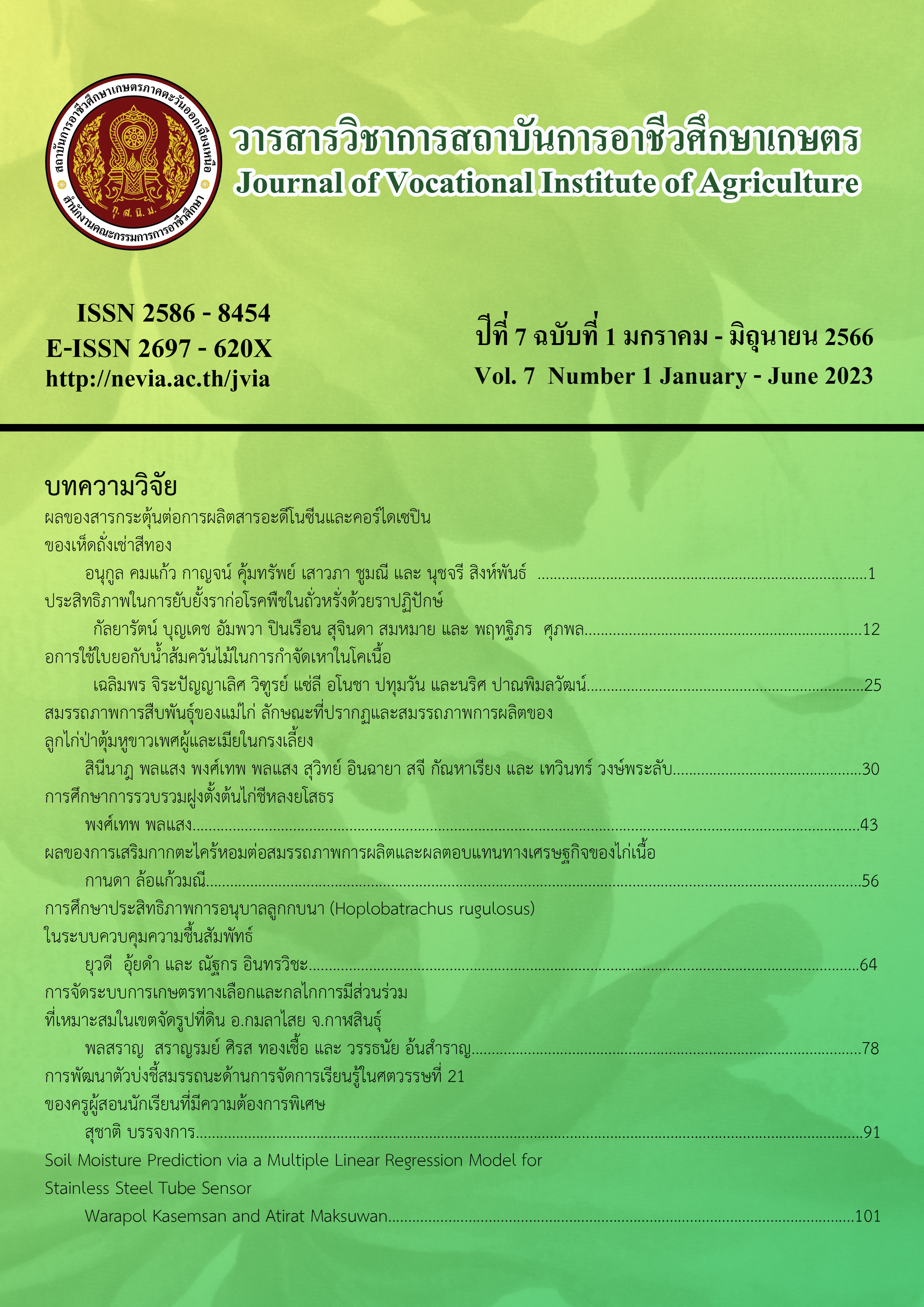Reproductive Performance of Hen, Phenotypic Characteristic, and Growth Performance of Young Male and Female Thai Red Junglefowl (Gallus gallus gallus) in Captivity
Main Article Content
Abstract
Thai red junglefowl (Gallus gallus gallus) is found in the forest of the Northeastern and Eastern regions of Thailand and nearby neighborhood countries. Biology information on the Thai red junglefowl is barely entry. The study's objectives were to investigate the hen’s reproductive performance, phenotypic characteristics, and growth performance of young male and female Thai red junglefowl. The aged 1 old year breeder; 1: 4 of males on females are raised in each cag, 3 cags in total. Twelve of each newborn male and female chicks were randomized separately to each pair per cag. They were raised under natural circumstances, given light 14 hours/day, providing feed and water ad libitum. It found that the hen’s reproductive performance, the average number of eggs laying is 82.90±12.94 eggs/hen/year, and the fertility and hatchability rates are 70.22 and 40.23% of total eggs incubated. The increased amount of rainfall does not correlate with the percentage of egg production; however, it correlates with the percentage of fertilized eggs. Anyhow, the increased amount of rainfall decreased the hatchability rate. The phenotypic characteristic at birth cannot be gender distinguished by feather color. The difference between males' and females' feather colors appeared after 2 months. The chicks become mature chickens with faster development than raising in the natural circumstance after 12 months. Both males and females have white earrings, a light-yellow new feather, and a black streak. The shape is slender, like a banana flower. Males are reddish in color with a slightly blackish tinge, slender tail feathers, and the base of the tail has fluffy white fur. Females have slightly reddish gray feathers and short tail feathers. The growth performance from birth to 1 month is nonsignificant different (P>0.05). From 1 to 7 months is greater in male phenotypic characteristics development than in females (P<0.01).
Article Details

This work is licensed under a Creative Commons Attribution-NonCommercial-NoDerivatives 4.0 International License.
The content and information in articles published in the Journal of Vocational Education in Agriculture are the opinions and responsibility of the article's author. The journal editors do not need to agree or share any responsibility.
Articles, information, content, etc. that are published in the Journal of Vocational Education in Agriculture are copyrighted by the Journal of Vocational Education in Agriculture. If any person or organization wishes to publish all or any part of it or to do anything. Only prior written permission from the Journal of Vocational Education in Agriculture is required.
References
KhobKhet, O. (1998). Birds in Thailand Volume 1. Bangkok: Sarakadee Press. (in Thai)
Lekagul, B. & Round, P. D. (1991). A Guide to the Birds of Thailand. Bangkok: Saha Kam Bhaet Co. Ltd.
Thai National Parks. (2006). Species of Thailand: Red junglefowl. Available from https://www.thainational parks.com/species/red-junglefowl. Accessed date: 6 November 2022.
Biodiversity Research Group. (2016). Kai Tang. Bangkok: Animal Breeding Division, Department of Livestock Development, Ministry of Agriculture and Cooperatives. (in Thai)
Fumihito, A., et al. (1994). One subspecies of the red jungle fowl (Gallus gallus gallus) suffices as the matriarchic ancestor of all domestic breeds. Proceedings of the National Academy of Sciences, 91(26), 12505-12509.
Akaboot, P., et al. (2012). Genetic characterization of Red Junglefowl (Gallus gallus), Thai indigenous chicken (Gallusdomesticus), and two commercial lines using selective functional genes compared to microsatellite markers. Genetics and Molecular Research, 11(3), 1881-1890.
Callaway, E. (2016). When chickens go wild. Nature, 529(7586), 270-273.
Polsang, S. (2020). The Conservation of Thai Red Junglefowl (Gallus gallus gallus) by Semen Cryopreservation. (Doctoral dissertation, Khon Kaen University). (in Thai)
Polsang, S., et al. (2022). A study of annual variation on semen characteristics of Thai red junglefowl (Gallus gallus gallus). Khon Kaen Agriculture Journal, 50(2), 505-515. (in Thai)
Hudson, J. (2022). How to Sex Chickens: 6 Ways to Determine Hen or Rooster. Available from https://cs-tf.com/how-to-sex-chickens/. Accessed date: 6 November 2022.
Statistical Analysis System Institute (SAS). (2018). SAS/STAT user’s guide SAS University Edition 9.4. North Carolina: SAS Institute Inc.
Department of Livestock Development. (2021). New Theory Agriculture Project: Raising native chickens. Bangkok: Ministry of Agriculture and Cooperatives. (in Thai)
Kongratananan, N. (1992). Study on growth and reproductive development of native chickens compared with some purebred chickens. (Master thesis, Kasetsart University). (in Thai)
Animal Breeding Research and Development Network Center (native chicken). (2022). Pra dooHang Dam chicken KKU 55 and Chee KKU chicken 12. Available from
https://home.kku.ac.th/ncab/pradu.php. Accessed date: 6 November 2022. (in Thai)
Elagib, H. A. A., et al. (2012). The effects of age and season on semen characteristics of white leghorn cocks under Sudan conditions. International Journal of Poultry Science, 11(1), 47-49.
Boone, M. A. & Huston, T. M. (1963). Effect of high temperature on semen production and fertility in the domestic fowl. Poultry Science Journal, 42(3), 670-676.
Joshi, P.C., et al. (1980). Effect of ambient temperature on semen characteristics of White Leghorn male chicken. Indian Veterinary Journal, 57(1), 52-56.

